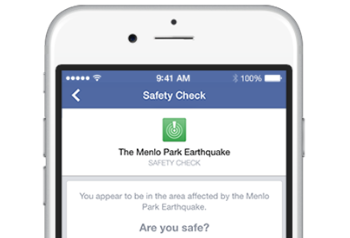 Facebook has some pretty impressive numbers and an important role in streamlining online communication and engagement to, let’s be honest, the world. Besides functioning as a platform for organizing an event, updating your friends on your life, or even keeping in touch with family members, Facebook has also used its influence to encourage users to register as an organ donor, as well as encourage users to get out and vote. Once again, Facebook is looking to use its massive influence for good. Today, Facebook has announced that a new feature is going to be added that will be both relevant and beneficial to an even bigger audience: Safety Check.
Facebook has some pretty impressive numbers and an important role in streamlining online communication and engagement to, let’s be honest, the world. Besides functioning as a platform for organizing an event, updating your friends on your life, or even keeping in touch with family members, Facebook has also used its influence to encourage users to register as an organ donor, as well as encourage users to get out and vote. Once again, Facebook is looking to use its massive influence for good. Today, Facebook has announced that a new feature is going to be added that will be both relevant and beneficial to an even bigger audience: Safety Check.
According to Facebook, the logic behind Safety Check came from the team’s experience with users in Japan during the 2011 earthquake and tsunami. According to TechCrunch, those two events combined affected 12.5 million people nationwide and brought about over 400,000 evacuations. During this time, Facebook’s engineers in Japan quickly developed and activated the “Disaster Message Board,” in the hopes of making it easier for those caught up in the situation to communicate with family and other friends. The following year, a test of the tool was launched, and according to Facebook, “the response was overwhelming.”
The aim behind Safety Check is that during a major disaster, you can easily and quickly notify family and friends that you are safe, as well as enable you to mark friends as safe. The way it is designed to work, users listed as being in the affected area will receive a notification asking them if they are safe (your location is pulled from what you have in your profile, or if you opt to use its “Nearby Friends” product, it will view your last location). If Facebook gets this information wrong, you can select the option that indicates that you are outside the affected area.
Finally, marking that you are safe requires nothing more than a tap on the green button which simply reads “I’m Safe.” Once you select it, a notification and a News Feed story will be posted to your profile. In addition, if you happen to be with a group of people, friends can also mark you as safe on your behalf. After you indicate that you are safe, the information will then be shared with other friends and family checking on people in the affected area. However, only your Facebook friends will be able to see what your current “safety status” is, as well as the comments you share. People who receive the notifications about their friends’ safety statuses could also view a list of all the updates, including friends in the affected area, friends who are marked safe, and friends who are not yet marked safe.
Safety Check, the end result of the “Disaster Board” experiment, will become available worldwide to users for their desktop, iOS, Android, and (astonishingly) even feature phones. Facebook recognizes that its platform has incredible potential to help it users during critical times, and its experience with the disasters in Japan during 2011 proved that:
“It is in these moments that communication is most critical both for people in the affected areas and for their friends and families anxious for news,” says Facebook. “We want to provide a helpful tool that people can use when major disasters strike, so we’ve created Safety Check – a simple and easy way to say you’re safe and check on others.”
While no one hopes to ever need to use the feature, “Safety Check” is undoubtedly one of the most appealing and useful features to be developed by Facebook. When disasters strike, often times chaos and pandemonium make it hard to let loved ones and family members know when we are okay. Facebook hopes to streamline that processes of assuring others almost instantaneously that we are safe, a feat that would be nearly impossible without social media.
Original article appeared on TechCrunch


